Services on Demand
Journal
Article
Indicators
-
 Cited by SciELO
Cited by SciELO -
 Access statistics
Access statistics
Related links
-
 Cited by Google
Cited by Google -
 Similars in
SciELO
Similars in
SciELO -
 Similars in Google
Similars in Google
Share
Lecturas de Economía
Print version ISSN 0120-2596
Lect. Econ. no.63 Medellín July/Dec. 2005
The Determinants of the Health Status in a Developing Country: Results from the Colombian Case
Determinantes del estado de salud en un país en vía de desarrollo: resultados del caso colombiano
Les déterminants de l'état de santé dans un pays en voie de développement: les résultats du cas de la Colombie
Juan Miguel Gallego, Manuel Ramírez y Carlos Sepúlveda
Juan Miguel Gallego: Department of Economics. Universite de Toulouse I 38, Rue des Marchands. 31000, Toulouse-France. E-mail adress: juan.jgallego@gmail.com. Manuel Ramírez Gómez: Department of Economics. Universidad del Rosario. Calle 14, No. 4-69, Bogotá, D.C., Colombia. Tel (57-1) 2970200 ext. 670, fax: (57-1) 3445763. E-mail address: maramire@urosario.edu.co. Carlos E. Sepúlveda: Department of Economics. Boston University 270 Bay State Road, Boston, MA, 02215, USA csepulve@bu.edu. The authors would like to thank Colciencias and Universidad del Rosario for financial support. We thank Hernán Jaramillo, David Rivera, Jorge Zambrano and Santiago Niño from Universidad del Rosario, for their comments, suggestions and support. We would also thank two unanymous referees for valuable comments.
-Introduction. -I. Institutional Background: The Colombian Health-Care Sector. -II. Methods. -III. Results. -V. Robustness of the Results. -Concluding Remarks.-References.
Primera versión recibida en junio de 2005; versión final aceptada en noviembre de 2005 (eds.)
Resumen: Este artículo encuentra evidencia empírica sobre los determinantes del estado de salud en Colombia, después de la reforma de 1993. El artículo usa la teoría de Grossman y analiza, además de características individuales y socioeconómicas, variables institucionales del sector. Se usaron dos encuestas para los años 1997 y 2000, las cuales cuentan con una medida subjetiva del estado de salud y con información sobre el tipo de afiliación. Se uso modelo econométrico Probit ordenado. Los resultados muestran una relación entre variables individuales, socioeconómicas, e institucionales con el estado de salud de las personas. Finalmente, aunque el tipo de afiliación al sistema parece aumentar las desigualdades en el estado de salud, se cumple el objetivo de enfocar la cobertura en sectores poblacionales vulnerables.
Palabras Clave: Demanda por salud, Producción de salud, Países en desarrollo, Estimaciones Probit. Clasificación JEL: JO, J23, J3
Abstract: We find empirical evidence of the health determinants as a measure of health capital in a developing country after a deep reform of its health-care sector. We use the model of Grossman and take, besides individual and socioeconomic variables, institutional variables. Two surveys from 1997 and 2000, with a subjective (self-report) health status of the individuals, and information about the health system affiliation type, were used. The estimation method is an order probit model. The results show an important connection of individual, institutional and socioeconomic variables with the health status. Although the access to medical care seems to strength the inequities in health outcome, the purpose of the social security reform of affiliating the vulnerable population is met.
Key words: Demand for health; health production, developing countries, probit estimations. JEL classification: JO, J23, J3
Résumé: Cet article se propose de présenter de l'évidence empirique sur les déterminants de l'état de santé en Colombie après la réforme de 1993. D'après le modèle de Grossman, nous faisons une analyse des caractéristiques individuelles et socio-économiques, ainsi que des variables institutionnelles du secteur. Nous avons utilisé deux enquêtes, l'un de 1997 et l'autre de 2000, qui ont mesuré subjectivement l'état de santé des individus et qui apportent de l'information sur le type d'affiliation. L'estimation a été faite avec un Modèle Econométrique Probit Ordonné. Les résultats montrent un rapport entre les variables individuelles, socio-économiques et institutionnelles et l'état de santé des personnes. Finalement, bien que le type d'affiliation au système de santé semble augmenter les disparités dans l'accès aux services de santé, on a atteint le but de couverture des secteurs de la population à risque.
Mots clés: demande de santé, production de santé, pays en voie de développement, estimations Probit. Codes JEL: JO, J23, J3.
Introduction
The estimation of the determinants of health status is an important input for public policy. It helps to understand the risk of specific habits and its effects in productivity and economic growth (Savedoff and Schultz 2000). It also brings information to the policy makers about the effects of particular public strategies in the health condition of the population (Gerdtham et al. 1999).
The approach of this paper follows the Health Demand Theory, making a distinction between the demand for health and the demand for health care (Grossman 1972). From the theory of human capital formulated by Becker (1965), Grossman built a model where health is viewed as an investment in human capital and as an output of household production processes (Jones et al., 2003). Individuals demand health not only because of utility reasons -feeling well makes you feel better- but because it generates future healthy time which would have an impact on the productivity of the person and his utility function. Individuals are assumed to invest in health production until the marginal cost of health production equals the marginal benefits of improving health status.
Grossman (1972) explains theoretically the determination of the health status. Many epidemiologists have stressed the importance of the relationship between socioeconomic status and health outcomes, often implying a causal relationship running from the former to the latter. Works by Wagstaff (1993), Gerdtham et al. (1999), Grossman (2000) among others, present empirical evidence about this relationship. In Colombia, Ribero and Nuñez (2000) study the effects of health conditions on productivity, finding intermediate results of socioeconomic determinants of health status. They used a Colombian survey from 1991, before a structural reform of the health sector took place in 1993. The dependent variable measuring health was an anthropometrics measure -height of a person.
This paper tries to find empirical evidence of health determinants as a measure of health capital in a developing country after a deep reform of its health-care sector. Contrary to Ribero and Nuñez (2000), two surveys from 1997 and 2000 in Colombia, with a subjective (self-report) health status of the individuals and information about the health system affiliation type were used. Although both surveys do not create a panel data, important hypotheses can be confirmed from two different periods of time, with different economic and social conditions in the country.1 This could be relevant for the evaluation of the health reform.
The non observability of the health capital (health status) is a main issue in the empirical analyses (Folland et al., 2001; Wagstaff, 1993 and Baker et. al., 2001). A subjective measure of the health status is used in this case through a question in both surveys about the individual perception of his health condition -poor, fair, good or excellent. The variable is based on a simple survey question that has high reliability, but does not yield a continuous health status measure, making difficult to interpret the size of the regression coefficients in a demand-for-health regression equation (Baker et al., 2001). The estimation method is an order probit model.
The Health Sector in Colombia was deeply transformed in 1993 under a central purpose of improving the population health status throughout the reduction of the health services barriers. The improvement of health insurance coverage is notorious in the first three years of implementation; the percentage of people with access to health insurance changed from 20% in 1993 to 55% in 1997 and 57% in 2000 (Jaramillo 1999; Bitran and Asociados and Econometría, 2002), showing a very slow evolution in health insurance coverage during these last years. The health insurance plans designed in the system differ in terms of conditions and quality. We believe that these differences have an effect in the health status of people with different coverage types and the fact that poor peoples access to a lower quality health service widens the gap between social sectors. Under these circumstances it is important to study the individual, family, and community characteristics that determine the health status of an individual.
The paper is presented as follows. The next section briefly explains the Colombian health-care sector after the reform in 1993. The third section explains the methodology, including the data, hypothesis and model implemented. The fourth section presents the estimation results and, finally, we conclude.
I. Institutional Background: the Colombian Health-Care Sector
The health-care system in Colombia was deeply transformed in 1993 and rebuilt under the principles of efficiency, universality, and solidarity. A public and protectionist national health system, with a centralized and vertical organization was changed into a social security system based on insurance processes, competition between the insurance administrators and the suppliers, and a redistribution capacity to transfer resources to subsidize the poor population (Londoño, 1996; Yepes, 2000; Trujillo, 2003, McPake et al., 2003). The main objective of the reform was to build adequate and general access conditions to the system, bringing, as a consequence, an improvement on the population's health status.
Two parallel regimes under the health-care social security system were built. A contributive regime, to which all workers must affiliate -employees and independent workers with a minimum payment capacity established by the government-, and a subsidized regime, for those with no payment capacity and with the need to be financially helped by the State -partially or totally- in order to have access to health care. All citizens have to be affiliated to one of the two regimes. Nevertheless, given the later evolution of the system and the macroeconomic performance in Colombia, there has been a very important percentage of the population not covered by any type of health insurance -45% in 1997 and 43% in 2000 (Jaramillo 1999; Bitran and Asociados and Econometria 2002). The people without payment capacity, but not poor enough to be subsidized or people evading the payment are both in this group.
A mandatory payroll tax of 12% of the worker's labor income enters the contributive regime. The family of the employee is covered by the insurance. The payment is split between the workers (4%) and their employers (8%), while the self-employed contribute 12% of their income. The affiliation process conducted by private and public intermediate institutions, called Entidades Promotoras de Salud (EPS), which offer a health plan (POS) regulated by the Consejo Nacional de Seguridad Social en Salud -CNSSS (National Council of Social Security in Health), integrated by members of the government, unions, and the institutions involved in the system. The contribution is transferred by the EPS to the (Fondo de Solidaridad y Garantía) -FOSYGA (Trujillo, 2003), which is a public fund that distributes the contribution among the affiliated people not only in the contributive regime but also in the subsidized regime. The EPS receive from the FOSYGA a payment for each individual enrolled, differentiated by age, sex, and residence region 8,3% of the transfer made by the EPS to the FOSYGA is redistributed to cover part of the affiliation of the poor people into the security system -under the second type of regime.
To determine the economic and social conditions of the individuals, a survey (SISBEN) is made. The population is divided into six socioeconomic groups (estratos), with group 1 being the poorest and 6 the least poor. The individuals from groups 1 and 2 enter into the social security system through the subsidized regime. Groups 1 to 3 are all to some extent a vulnerable population and therefore the focus of the different public subsidies.2 An affiliation to a health plan (POS) has to be made through special sickness funds, called Administradoras de Régimen Subsidiado (ARS). Their funding depends on a percentage of the contributive regime income and a financial support from the central and local governments, transferred from FOSYGA. The ARS play the same role in the subsidized regime as their counterparts (EPSs) in the contributive regime.
Two complementary health care access types work in the health system. On the one hand, a public safety net (GP) is promoted trying to serve the low-income population not covered by the subsidized program and not qualified for the contribution plan (Población Vinculada), it is usually locally promoted and it is financed by general tax revenues. The quality of the services is low, the access is limited and the services package is minimal. On the other hand, a traditional private health insurance (PI) is available and any individual can pay for a specific health plan managed by a private institution. This option is not a substitute, but complementary, to the contributive regime affiliation.3
The conditions offered by the POS, POSS and the GP are quite different. At the moment, the quality of health care services of the POS is much greater than the quality of the POSS and the GP. This is true because of the number of services included in each package and the number of health care service institutions available for the different regimes.4 The difference between health plans suggests that people in the contribution regime tend to have better health conditions than those in other regimes, not only because of their socioeconomic conditions, but because of greater access to the social security system and the better services received.
II. Methods
A. Model and Hypothesis
A model for health demand following the framework of Grossman (1972) is the base of the estimation. As explained before, health is viewed as an investment in human capital and as an output of the household production process. Individuals demand health to increase their utility today and to have more healthy time available for market and non-market activities in the future (Jones et al., 2003).
Assuming first that consumption benefits are equal to zero -pure investment- the optimal decision is such that the marginal efficiency of capital (MEC) is equal to the opportunity cost of capital. If MEC is inelastic, the model predicts older people invest more time in health than younger ones. At the same time, as the wage increases, the demand for health rises although not necessarily the demand for medical care -given the substitution incentives between medical care and time. The same result holds for education. Such conclusions are ambiguous in the pure consumption or consumption-investment model.
Empirical studies have tried to find some answers. Grossman (1972) tests his model using US data finding a positive effect of wages, education, and age on the demand for health. Later studies confirm these results for other countries aas well as for the U.S., e.g. Wagstaff (1993) and Gerdtham et al. (1999).
The set up of our model is the following:
Hi = b1 * Yi + b2 * Ei + b3 * Di + b4 * Ii + b5 * Si + mimi is an error term with zero mean and constant variance. b1-b5 are the unknown coefficients to be estimated. Hi is the health status of the individual i. Yi and Ei are the income and education of the individual i, respectively. The depreciation of health, represented by Di, is a vector of exogenous variables that affect the rate of depreciation during the life cycle. Socio economic (Si) and institutional health system (Ii) variables are also considered as determinants.
The reason to include additional socioeconomic and institutional variables is pointed out by Ross and Mirowsky (2000). Although the relation between socioeconomic status and health is well established, it is not clear if this is a causal relation or because people with higher income have access to different kinds of insurance policies which would give them better health. Trying to deal with such possible bias made us include these additional controls.
A priori, taking into account the current evidence in other countries and the pure-investment set up, is expected that the income of the individual has a positive effect on his health status (b1>0); a person with higher income has better life conditions and greater payment capacity for access to good nutrition and quality health services. A wealthy person also tends to invest more in health production resulting in a better health status. The situation is similar with education Ei, (b2>0) and socioeconomic variables (Attanasio and Emmerson 2001; Ross and Mirowsky 2000). The institutional variables affect the conditions of health, depending of the quality and the number of services offered to the individual (Ross and Mirowsky 2000).
B. Data
Two data surveys were used. The "Encuesta Nacional de Demografía y Salud -ENDS2000" (demographic and health national survey 2000) elaborated by Profamilia,5 covers 47.520 people and 10.905 households in different regions of Colombia and asks for demographic and institutional health conditions, including a self-report of the individuals health perception. The "Encuesta de Calidad de Vida de 1997 ECV97" (living standard measurement)6 is the major survey about life-quality survey in Colombia (national wide representative) with data of 29 of the 33 states in Colombia, covering 38.518 people and 9.121 households, and elaborated by the government statistics agency "Departamento Administrativo Nacional de Estadística (DANE)" in 1997. Sub samples of 28.477 individuals and 15.315 are taken from the ENDS2000 and the ECV97, respectively -labor force participant, from 16 to 65 years old.
The two surveys were made in different periods, both crucial in the health reform implementation process. The ECV97, was conducted three years after the new system had been established and the economy and employment were improving. The health insurance coverage in both regimes reached 55%. In 2000, when the ENDS2000 was implemented, Colombia was consumed in a critical economic situation, with the deepest depression in 50 years. The health insurance coverage in that year reached 57%, just two points above from three years earlier and far away from the 100% coverage goal.
C. Variables
The data used in the analysis are defined in Table 1 and summary statistics for these variables are given in Table 2. The health status of an individual is measure as the individuals perception of his health condition -poor, fair, good or excellent. The variable is based on a simple survey question with high reliability.7
The independent variables are taken as follows. The income is represented as the natural logarithm of household income, and a discrete variable differentiating type of occupation is introduced. The occupation of the individual tends to be positively related with his earnings. We expect the health condition to improve as the income increases and as the occupation type is more stable and safe. We also control by the level of education -no education, elementary, high school, undergraduate and post-graduate.
Variables like age and gender are taken as determinants of the rate of depreciation in health (Gerdtham et al.,1999). Age is a continuous variable and the gender is a dummy variable that distinguishes between male and female. We expect the age to affect positively the rate of depreciation of capital health, since the health status decreases with age.
Table 1. Definition of variables
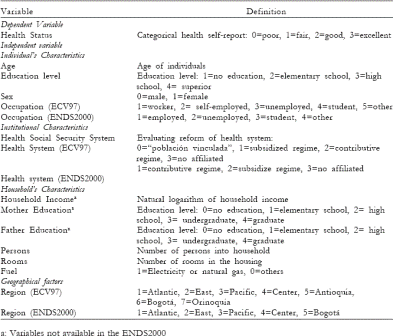
a: Variables not available in the ENDS2000
For socioeconomic conditions, variables as mother's and father's education, rooms and number of people in the households, type of fuel used for cooking and geographical location are used (Akin et al., 1998; Savedoff and Schultz, 2000; Ross and Mirowsky 2000; Trujillo 2003). The education of the mother and the father are measured in the same way that the individual's. The type of fuel is measured as a dummy variable of one (1) for electricity or natural gas, and zero (0) for other types of less quality fuel. The geographical location is included because of the importance of regional differences in Colombia. This variable is a vector of dummies that controls for the different regions: Atlantic, East, Pacific, Center, Antioquia, Bogotá, Orinoquia. In the ENDS2000 Antioquia is included into the center region and Orinoquia into the east region. The levels of earnings, quality of life, and labor conditions are generally worse in the coastal region than in the interior (Ribero and Nuñez, 2000).
Table 2. Sample descriptive statistics
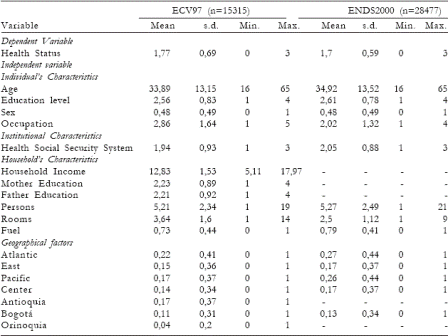
As an institutional variable for the health system, a differentiation through a dummy was made between the insurance type -población vinculada (i.e. not affiliated and without payment capacity), subsidized, contributive or non-affiliated. We believe that people in the contributive system tend to have better health condition than the rest of the population, because of the higher quality of its services, the wider package plans, and the better socioeconomic outcomes. The comparison between the subsidized regime and the no-affiliation group without payment capacity (i.e. población vinculada) is ambiguous because this last group is largely composed by people classified in group 3 of the socioeconomic status. People from group 3 have less health care services but a better socioeconomic background.
In this context, individual variables -such as age, education, gender, occupation (following Gerdtham et al., 1999)-, institutional variables (such as the health system affiliation type), and environmental variables (such as family income, mother and father education, number of rooms in the household, the geographical position, and the type of fuel used for cooking; Akin et al.1998; Savedoff and Schultz 2000), are taken as determinants of the individual's health status.
D. Estimation method
Order probit estimations were implemented. This methodology is used given the categorical condition of the health status variable -it takes values from 0 to 3, if the person health status is poor, fair, good or excellent- (Wooldridge, 2002; Greene, 2000).
Following Greene (2000) the order probit model is built around a latent regression given by:
H* = β' X +ε ε~N(0, σ2)
The health condition is unobserved, but an individual's self-report of his health status is taken as an index, defined as:
H = 0 if H* £ m0 ,
H = 1 if m0 < H* £ m1 ,
H = 2 if m1 < H* £ m2 ,
H = 3 if m2 < H* £ m3
The unknown's are estimated simultaneously with the. With the normal distribution the following probabilities are obtained:
Pr ob(H = 0) = F(m0- β' X),
Pr ob(H = 1) = F(m1 - β' X) - F(m0 - β' X),
Pr ob(H = 2) = F(m2 - β' X) - F(m1 - β' X),
Pr ob(H = 3) = 1- F(m2 - β' X)
where m0 < m1 < m2 , in order for the probabilities to be positive.
III. Results
Once an order probit model was estimated, most of the intuitions that emerged from the descriptive statistics of conditional probability (Table 3) were confirmed and the results from both surveys were quite similar.
The results present a consistent relationship between health and the different variables (see Table 4). Changes in current household income and education have positive effects on a person's health; as a person becomes older his health condition decreases and an employee has a lower chance of having a regular or bad health status than a student or unemployed person (maybe because he/she has relatively more stability and less risk). These results are according to theoretical and empirical exercises like Grossman (1972, 2000), Akin et al. (1998) and Gerdtham et al. (1999).
The estimation also shows that women tend to have worse health than men. Although women have longer life expectancy than men, this result seems to be consistent with the existing literature. According to the World Health Organization (1998), "despite their greater longevity women in most communities report more illness and distress than men (Rahman et al., 1994; Rodin and Ickovics, 1990; US National Institutes of Health, 1992). The precise details of this excess in female morbidity and the factors that lie behind it will vary in different social groups, but the broad picture is one where women's lives seem to be less healthy than those of men (Macintyre, 1996). The explanation for this apparent paradox lies in the complex relationship between biological and social influences in the determination of human health and illness".
According with the expectations, the people affiliated to the social security system through the contributive regime (EPS-POS) tend to have higher health conditions, compared with people affiliated through the other regimes (ARS-POSS, vinculados or GP). An individual not affiliated to the system with or without payment capacity has a better health condition that those in the ARS-POSS. This can be explained because there is a good portion of evasion in the contributive system and people with payment capacity use the governmental program and do not enter the formal system. There are estimations of evasion/elusion around 35% in 2000 (Bitran and Asociados and Econometria 2002). Moreover, people in the regime of "población vinculada" have higher socioeconomic backgrounds than those affiliated to the subsidized regime (i.e. the 90% of the population in the subsidized regime belongs to groups 1 and 2 in the ECV97). The household income from a person of group 3 and included in the regime of "población vinculada", in average, has twice the household income of a person included in the subsidized regime. These higher economic differences might explain an income effect to explain the fact that people in the subsidized regime have the lowest self-perception of their health status.
The results about social economic status are clear. Better social and economic position affect the health condition in a positive way. The more rooms a home has the better the health status and if the family cooks with electricity or natural gas the better their health status than compared to other fuels. The health status falls as the number of individuals in a home increases. People living in Bogotá and Antioquia -the capital and one of the richest states, respectively- are in better conditions that the population in the rest of the country. As the education of both the mother and the father increases, so does the health of the person.
The probabilistic models estimations suggest that the health status of the colombians -as a measure of the health capital stock -is influenced by two types of variables: those which are referred to the basic model of Grossman such as the current income, age and education, and those specifically for the Colombian case. The geographical condition, for instance, improves the health perspective of a person if he lives in Bogotá or the Antioquia region. The beneficial plans, like the contributive ones, have important and positive effects compared with the subsidized or the governmental plans. The demographic conditions and the family size also influence person's health.
Table 3. Conditional Probabilities
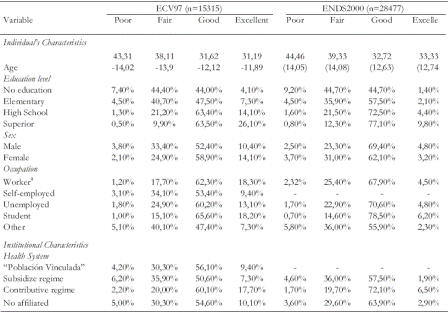
Table 3. Continuation
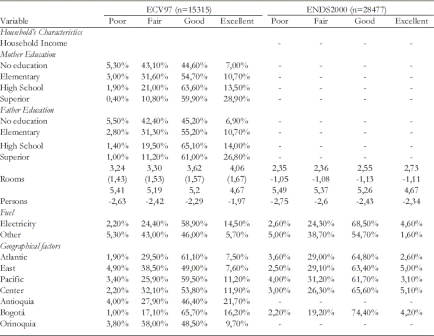
a In the ENDS2000 worker is employed, included worker and self-employed.
Table 4. Order Probit Estimation
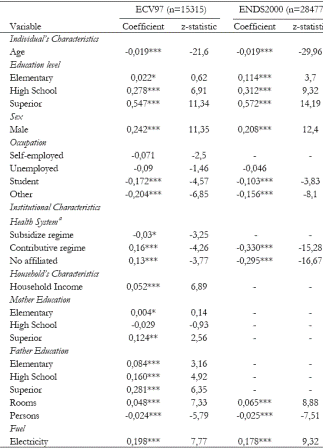

a: ENDS2000 Health system is composed by subsidized regime (referent group in the estimation), contributive regime and no affiliated. *** P<0.01, **P<0.05, *P<0.10
IV. Robustness of the Results
In order to check our result and for robustness analysis, we run different setups of the general model. For this check up we use the ECV97 because income information is available. First, the pure Grossman model -just income and education as explanatory variables, controlling for age and gender- was run first (Table 5 Column 1). The results show positive and significant coefficients of income and education and a negative effect of age, as expected.
Including the explanatory variable of social security affiliation type (Table 5 Column 2), neither the sign nor significance of the basic model's variables change. At the same time, the results show that people affiliated through the subsidized regime have a lower health status than the ones not affiliated. This would indicate an adverse selection problem in the system as a whole and the purpose of affiliating the vulnerable population is met. We keep having these results along the different specifications.
Column 3 of the table includes the occupation variables, looking to incorporate other institutional factors. Given the legal framework, the chance of haveing access to the system increases if the person is under a labor contract. Again, the regression shows additional elements of the system not captured in the pure model. There is a negative and significant (at 10%) gap between worker and self-employed. Between worker and not employed the result is not significant. This could make sense given the structure of the survey. The unemployment status asks for a period of one month. A part of the population could have lost their jobs, were in the social system while they were working and kept the status.
When the education of the mother is considered together with the variables explained before in Table 5, their effect is positive. Nevertheless, including father's education drives the effect away and is the father's years of schooling explain part of the health status. One possible reason for this is the importance of the father's income as a component family income -which would determine other unmeasured socioeconomic conditions (see Table 5 Columns 4 and 5). Even if the income effect coming from the father's education is important the final model includes both mother's education and father's education as explanatory variables, following the traditional literature on health.8
Finally, the rest of the variables were included, i.e. number of people and rooms in the household, fuel type, and household localization by region. The results follow the international literature. More people and fewer rooms in the households represent less care for a specific individual. Less environment-compatible fuel represents less health for a specific person.9 The geographical condition, for instance, improve the health perspective of a person if he lives in the more developed regions. Several studies in Colombia have stated that the inequalities in health and health insurance are strength across the regions and even more within regions (i.e. between rural and urban areas in each region).10 These regressions show the extend to which a broader set-up is useful. Including institutional and socioeconomic explanatory variables in the Grossam model for the Colombian case, would give additional information not shown in the pure-model.
Table 5. Order Probit Estimation Robustness of the results
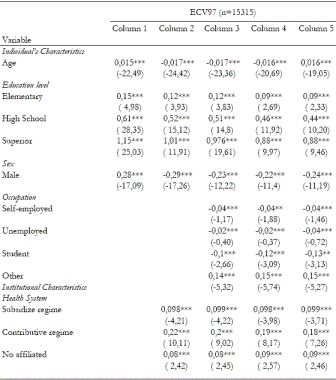
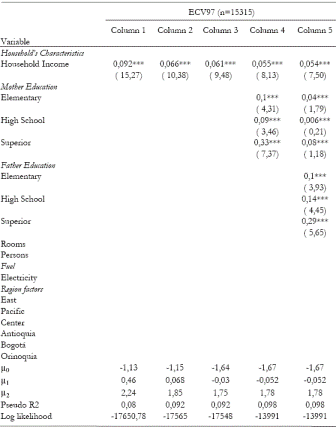
*** P-value<0.01. ** P-value<0.05. Z-statistic on parenthesis.
Concluding Remarks
Order probit estimation confirmed the initial hypothesis about health status determinants. Therefore, the health status of the Colombian people, as an indicator of health capital stock, seems to be determined by two groups of variables. Individual variables as income and education tend to influence positively the health of an individual, while age influences it negatively. A group of institutional or socio-economic variables also affects the health status of a person. An individual in a good employment position in terms of income, living in urban and relatively rich geographical region brings a greater chance of perceiving a good health status. Although people in the contributive regime have better health conditions than the ones in the subsidized regime (the poorest population), which would suggest that the medical care system strengths the inequalities in terms of health, the purpose of the reform affiliating the vulnerable population is met.
Notas
1 The EDS2000 was used as a reference to compare the estimation in the ECV97. However, information about income was not available in the demographic survey. This was the main reason for not taking into account the demographic survey in 1995. Other interesting surveys like CASEN 1993 are available but were not useful for our purpose because they were implemented before the social reform.
2 Groups 4 to 6 are the population with payment capacity and must access to health care services through contributive regime. The lower bound of this group could be very similar in terms of socioeconomic background to the upper bound of group 3, which is a recipient of public subsidies.
3 However, some people with payment capacity, who should be affiliated to the contributive regime, evade the system (i. e. 9% in the ECV97) and use private medical care services.
4 The Colombian legislation on health (Ley 1000, 1993) states that the differences in the health plan among regimes must be transitory. However, the transition time is not well defined and the government has postponed the time at which the gap should be closed. By the time of the data the POS included more services with respect to diagnostic, treatment and rehabilitation in the three different levels of medical attention (primary, secondary and tertiary).
5 Asociación Pro-Bienestar de la Familia Colombiana. The International Planned Parenthood Federation (IPPF) affiliate in Colombia.
6 This survey follows the procedure of the World Bank living standard surveys.
7 The data shows that people without a chronic illness perceive a better health status (probability of 75%). At the same time, people that have not had health problems in the 30 days before from the date the survey was conducted tend to perceive a better health status than those who have had health issues (76% against 56%). The data is consistent with this statement. The dependent variable is a subjective variable of health perception. It may be correlated with income and education (Baker et. al. (2001)). However, as several authors have explained, the use of self-report as the dependent variable is a good approximation to the measurement of health capital (see Baker et al. (2001), Gerdtham et al. (1999), and Wagstaff (1993)). Fore a more complete discussion of the benefits and pitfalls of using a subjective dependent variable see Baker et al. (2001).
8 The main results of the literature on the effect of parent's education states that mother's education is more important that father education to explain the health results, after controlling by income and economic conditions (Folland et al.; 2000).
9 Regressions interacting number of people in a household and number of rooms were considered also. The results don't change.
10 For a more complete analysis of health and health servies inequalities in Colombia see Florez and Tono (2002) and Florez et al. (2003).
References
1. Akin, John; Guilkey, David; Hutchinson, Paul and McIntosh, Michael, 1998, "Price Elasticities of Demand for Curative Health Care with Control for Sample Selectivity on Endogenous Illness: An Analysis for Sri Lanka", Health Economics, No. 7, pp. 509-531. [ Links ]
2. Attanasio, Orazio and Emmerson, Carl, 2001, "Differential Mortality in the UK", The Institute for Fiscal Studies, Working Paper 16. [ Links ]
3. Baker, Michael; Stabile, Mark and Deri, Catherine, 2001, "What do Self-Reported, Objective, Measures of Health Measure?", National Bureau of Economic Research, Working paper 8419. [ Links ]
4. Becker, Gary, 1965, "A Theory of the Allocation of Time". Economic Journal, No. 75, pp. 493-517. [ Links ]
5. Bitrán and Asociados, Econometría, 2002, "Evaluación y reestructuración de los procesos, estrategias y organismos públicos y privados encargados de la afiliación, pago y recaudo de aportes al sistema", Reporte Final, Ministerio de Salud, Colombia. [ Links ]
6. Flórez, Carmen Elisa y Tono, Teresa, 2002, La equidad en el sector salud: una mirada de diez años, Fundación Corona, Documento de trabajo No. 6. [ Links ]
7. Flórez, Carmen Elisa, Tono, Teresa, Ribero, Rocio y Samper, Belén, 2003, Health, Nutrition, Human Capital and Economic Growth in Colombia 1995-2000, Documento Cede 2003-29. [ Links ]
8. Folland, Sherman; Goodman, Allen and Stano, Miron, 2001, The economics of health and health care, New Jersey, Prentice-Hall. [ Links ]
9. Gerdtham, Ulf-G; Johannesson, Magnus; Lundber, Lena and Isacson Dag, 1999, "The Demand for Health: Results from New Measures of Health Capital", European Journal of Political Economy, No. 15, pp. 501-521. [ Links ]
10. Greene, William, 2000, Econometric analysis, New Jersey, Prentice-Hall. [ Links ]
11. Grossman, Michael, 1972, "On the Concept of Health Capital and the Demand for Health", Journal of Political Economy, No. 80, pp. 223-255. [ Links ]
12. Grossman, Michael, 2000, "The human capital model". In: Culyer, A. and Newhouse, J. (ed.). Handbook of health economics, North-Holland. [ Links ]
13. Jaramillo, Ivan, 1999, El futuro de la salud en Colombia. La ley 100 de 1993 cinco años después. Bogotá, FESCOL, FES, FRB y Fundación Corona. [ Links ]
14. Jones, Andrew; Rice, Nigel and Contoyannis, Paul, 2003, The Dynamics of Health, Working Paper, ECuity Proyect. Erasmus University Rotterdam. [ Links ]
15. Londoño, Juan Luis, 1996, Managed Competition in the Tropics. Paper presented at the International Health Economics Association Inaugural Conference, Vancouver, May. [ Links ]
16. Macintyre, Sally, 1996, "Gender Differences in Health", Social Science and Medicine, Vol. 42, No. 4, pp. 617-624 [ Links ]
17. McPake, Barbar; Yepes, Francisco Jose; Lake, Sally and Sanchez, Luz Helena, 2003, "Is the Colombian Health System Reform Improving the Performance of Public Hospitals in Bogotá?", Health Policy and Planning, No. 18, pp. 182-194. [ Links ]
18. Rahman, Omar; Strauss, John; Gertler, Paul; Ashley, Deanna and Fox, Kristin, 1994, "Gender Differences in Adult Health: an International Comparison", The Gerontological Society of America, Vol. 34, No. 4, pp 463-469 [ Links ]
19. Ribero, Rocio and Nuñez, Jairo, 2000, "Adult Morbidity, Height, and Earnings in Colombia". In: Savedoff, William and Schultz, Paul (ed.), Wealth from health. Linking social investments to earnings in Latin America. Latin American Research Network. Washington D.C, Inter-American Development Bank. [ Links ]
20. Rodin, Judith and Ickovics, Jeannette, 1990, "Women's Health: Review and Research Agenda as we Approach the 21st Century", American Psychologist, Vol. 45, No. 9, pp 1018-34. [ Links ]
21. Ross, Catherine and Mirowsky, John, 2000, "Does Medical Insurance Contribute to Socioeconomic Differentials in Health?", The Milbank Quarterly, No. 78, pp. 291-321. [ Links ]
22. Savedoff, William and Schultz, Paul, 2000, "Earnings and the Elusive Dividends of Health". In: Savedoff, William and Schultz, Paul (ed.), Wealth from Health. Linking Social Investments to Earnings in Latin America. Latin American Research Network. Washington D.C: Inter-American Development Bank. [ Links ]
23. Smith, James, 2004, Unravelling the SES Health Connection, Institute for Fiscal Studies, WP04/0. [ Links ]
24. Trujillo, Antonio, 2003, Medical Care Use and Selection in a Social Health Insurance With an Equalization Fund: Evidence from Colombia. (forthcoming) Health Economics. [ Links ]
25. United States National Institute of Health, 1992, Opportunity for Research on Women's Health (NIH Publication no 92-3457), Washington, DC: US Department of Health and Human Services [ Links ]
26. Wagstaff, Adam, 1993, "The demand for health: an empirical reformulation of the Grossman model", Health Economics, No. 2, pp. 189-198. [ Links ]
27. Wooldridge, Jeffrey, 2002, Econometric analysis of cross section and panel data. Cambridge, Massachusetts Institute of Technology Press. [ Links ]
28. World Health Organization, 1998, World Gender and Health: Technical paper. Reference: WHO/FRH/WHD/98.16 [ Links ]
29. Yepes, Francisco José, 2000, "Health Reform and Equity in Colombia". In: Lloyd-Sherlock, P. (ed.), Health care reform and poverty in Latin America, ILAS Series. London, Institute of Latin American Studies, University of London. [ Links ]














